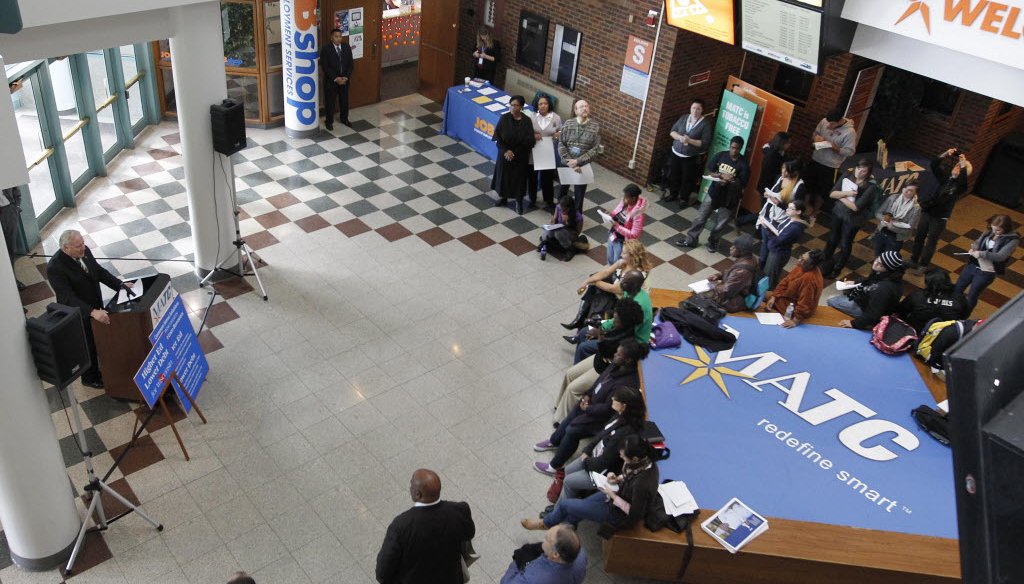Stand up for the facts!
Our only agenda is to publish the truth so you can be an informed participant in democracy.
We need your help.
I would like to contribute

Democratic state lawmakers held a news conference at Milwaukee Area Technical College on Oct. 23, 2013, to announce a proposal to help Wisconsinites refinance their student loan debt.
Nelson flubs comparison between student loan debt, real wages
If Your Time is short
-
Student loan debt increased roughly 100% since 2010.
-
But weekly earnings for employees have actually increased roughly 11% over thesame 10-year time frame, when adjusted for inflation.
It’s not 2022 yet, but Wisconsin’s U.S. Senate candidates are already making their priorities known.
Outagamie County Executive Tom Nelson, a Democrat, has repeatedly expressed support for increasing taxes on wealthier Americans, presenting himself as a stark contrast to Republican U.S. Sen. Ron Johnson — who has not yet announced whether he will seek a third term.
In an April 11, 2021 tweet, Nelson used the issue of student loan debt to further his argument.
"Since 2010, student debt has increased by 102% and real wages have *fallen* by over 8%," he tweeted.
Is Nelson on to something here?
Not exactly.
When asked for evidence to support Nelson’s claim, his campaign acknowledged that they couldn’t find data to match the specific numbers he cited and deleted the tweet. But they argued the broader point still stands — that student loan debt is outpacing wages.
So, we decided to take a look at the numbers.
First, a programming note: There are multiple measures for analyzing economic trends over time. Nelson cited real wages — or wages adjusted for inflation — so that will be our focus here.
According to data from the U.S. Bureau of Labor Statistics, the annual average weekly earnings for all employees sat at $353.53 in 2010 and increased 10.8% to $391.90 in 2020. (Note: These numbers are all in 1982-84 dollars, per the standard used by BLS.) For production and nonsupervisory employees, weekly earnings increased roughly 11.5% over that 10-year period.
Featured Fact-check
So, real wages haven’t fallen. Quite the opposite — they have increased.
Meanwhile, data from the Federal Reserve of St. Louis showed the total student loans owed in the fourth quarter of 2010 sat at around $855 billion. That skyrocketed to $1.7 trillion by the end of 2020, which was a nearly 100% increase.
What’s more, Experian found that the average individual loan balance grew by over $3,000, or 9%, from 2019 to 2020 alone and 6% from 2015 to 2019.
That means Nelson was generally on target with how much student debt has risen.
But he flubbed the comparison.
In a since-deleted tweet, Nelson said "since 2010, student debt has increased by 102% and real wages have fallen by over 8%."
Student loan debt has increased astronomically during that time period, so Nelson was on the mark there. But weekly earnings for employees have not fallen — they have gone up roughly 11% since 2010, when adjusted for inflation.
A statement is Half True when it is partially accurate but leaves out important details or takes things out of context.
That fits here.
Our Sources
-
Thomas Nelson, Twitter, May 7, 2021.
-
Email from Nelson for U.S. Senate, April 22, 2021.
-
Bureau of Labor Statistics, Average weekly earnings of all employees, 1982-1984 dollars, total private, seasonally adjusted, accessed May 10, 2021.
-
Bureau of Labor Statistics, Average weekly earnings of production and nonsupervisory employees, 1982-84 dollars, total private, seasonally adjusted, accessed May 10, 2021.
- Experian, Student Loan Debt Reaches Record High as Most Repayment Is Paused, Feb. 24, 2021.
Browse the Truth-O-Meter
More by Haley BeMiller
Nelson flubs comparison between student loan debt, real wages
Support independent fact-checking.
Become a member!
In a world of wild talk and fake news, help us stand up for the facts.


















































